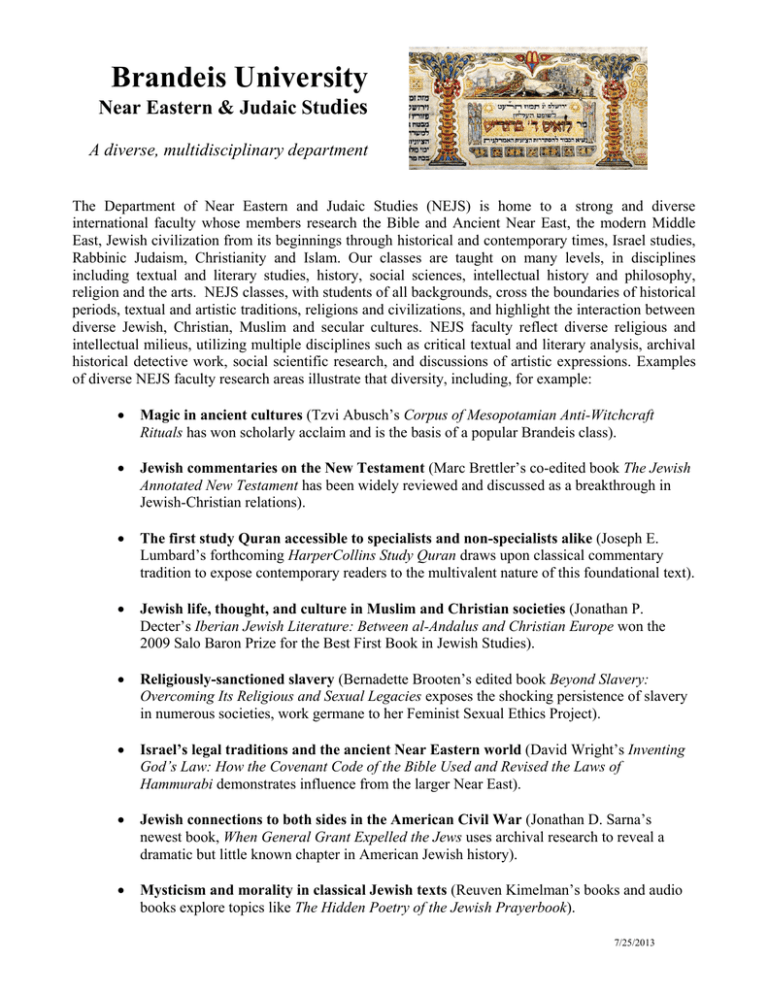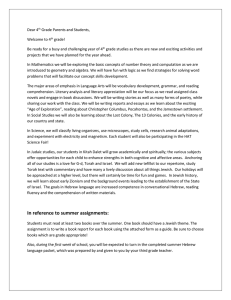
Brandeis University
Near Eastern & Judaic Studies
A diverse, multidisciplinary department
The Department of Near Eastern and Judaic Studies (NEJS) is home to a strong and diverse
international faculty whose members research the Bible and Ancient Near East, the modern Middle
East, Jewish civilization from its beginnings through historical and contemporary times, Israel studies,
Rabbinic Judaism, Christianity and Islam. Our classes are taught on many levels, in disciplines
including textual and literary studies, history, social sciences, intellectual history and philosophy,
religion and the arts. NEJS classes, with students of all backgrounds, cross the boundaries of historical
periods, textual and artistic traditions, religions and civilizations, and highlight the interaction between
diverse Jewish, Christian, Muslim and secular cultures. NEJS faculty reflect diverse religious and
intellectual milieus, utilizing multiple disciplines such as critical textual and literary analysis, archival
historical detective work, social scientific research, and discussions of artistic expressions. Examples
of diverse NEJS faculty research areas illustrate that diversity, including, for example:
Magic in ancient cultures (Tzvi Abusch’s Corpus of Mesopotamian Anti-Witchcraft
Rituals has won scholarly acclaim and is the basis of a popular Brandeis class).
Jewish commentaries on the New Testament (Marc Brettler’s co-edited book The Jewish
Annotated New Testament has been widely reviewed and discussed as a breakthrough in
Jewish-Christian relations).
The first study Quran accessible to specialists and non-specialists alike (Joseph E.
Lumbard’s forthcoming HarperCollins Study Quran draws upon classical commentary
tradition to expose contemporary readers to the multivalent nature of this foundational text).
Jewish life, thought, and culture in Muslim and Christian societies (Jonathan P.
Decter’s Iberian Jewish Literature: Between al-Andalus and Christian Europe won the
2009 Salo Baron Prize for the Best First Book in Jewish Studies).
Religiously-sanctioned slavery (Bernadette Brooten’s edited book Beyond Slavery:
Overcoming Its Religious and Sexual Legacies exposes the shocking persistence of slavery
in numerous societies, work germane to her Feminist Sexual Ethics Project).
Israel’s legal traditions and the ancient Near Eastern world (David Wright’s Inventing
God’s Law: How the Covenant Code of the Bible Used and Revised the Laws of
Hammurabi demonstrates influence from the larger Near East).
Jewish connections to both sides in the American Civil War (Jonathan D. Sarna’s
newest book, When General Grant Expelled the Jews uses archival research to reveal a
dramatic but little known chapter in American Jewish history).
Mysticism and morality in classical Jewish texts (Reuven Kimelman’s books and audio
books explore topics like The Hidden Poetry of the Jewish Prayerbook).
7/25/2013
Sex and the Shtetl—and what we can learn about Jewish marriages in Imperial Russia
from state court records (ChaeRan Freeze’s groundbreaking Jewish Marriage and
Divorce in Imperial Russia unearths unexplored resources in the FSU).
Changing understandings of pre-war Jewish life in Poland and the Holocaust and its
history and impact (Antony Polonsky’s 3-volume The Jews in Poland and Russia is just
one reason he received an honorary doctorate and two Officer’s Crosses from Lithuania and
Poland).
Central European Jewish intellectuals who reshaped the academy (Eugene Sheppard
unpacks influential Jewish thinkers in European and American thought in Leo Strauss and
the Politics of Exile: The Making of a Political Philosopher).
Middle Eastern and Islamic cultures historically and today (Kanan Makiya, Trustee of
the new post 2003 American University of Iraq in Sulaymaniya, is the creator of a 10
million page digital archive of documents at the Hoover Institution covering the Ba‘th era
in Iraq (1968-2003)).
How a more adequate theory of historical narratives might shape the way students
understand history and themselves (Jon A. Levisohn’s new book, The Interpretive
Virtues: A Philosophical Enquiry into the Teaching and Learning of Historical Narratives
argues that the teaching of history ought to cultivate, in students, the virtues of historical
interpretation).
What studying gender and religion reveals about American Jewish societies (Sylvia
Barack Fishman’s research shows that Jewish men often designate women to be the
signifying Jews, reversing patriarchy but yielding a new imbalance).
Museums as resources for understanding religion, history and culture (Ellen Smith
pioneers non-textual resources and museums courses for Brandeis.)
Intensive Hebrew immersion at Brandeis, Middlebury, and Ben Gurion (Vardit
Ringvald and the Hebrew language team offer 20 sections of Hebrew on and off campus.)
Hebrew literature and Israeli film and culture illuminate Israeli life (Ilana Szobel’s A
Poetics of Trauma: The Work of Dahlia Ravikovitch, forthcoming, examines poetry through
the lenses of gender, nationalism and trauma theory).
The Yiddish press Americanized the Jews (Ellie Kellman’s research on fiction reveals
the press as a key force in the process of acculturation and Americanization of the
immigrant Jewish community.)
Israel attracts worldwide attention—and Brandeis attracts worldwide students who
study Israel (Ilan Troen’s book, Jews and Muslims in the Arab World: Haunted by Pasts
Real illustrates why Israel studies are globally compelling; the Schusterman Center and the
Brandeis Summer Institute for Israel Studies hosts 160 faculty of all faiths and political
perspectives from 18 countries).






